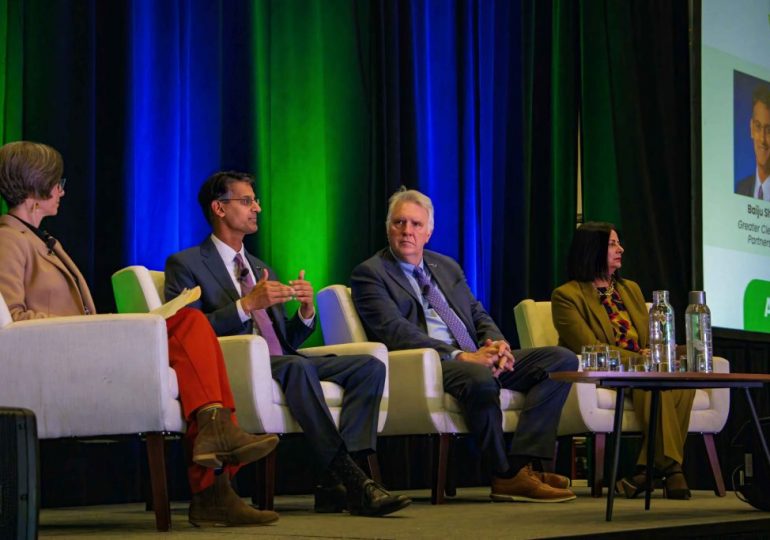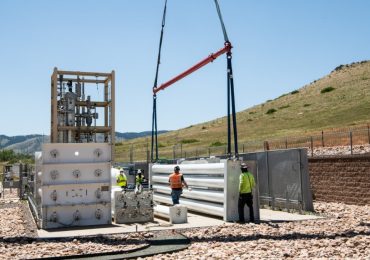Companies have a smoother road for getting management to greenlight clean energy projects now than they did five years ago, thanks to corporate climate commitments, federal incentives and more.
And if last month’s turnout of more than 800 people for the Greater Cleveland Partnership’s sustainability summit is any guide, businesses want support and guidance on navigating a process that is more compelling yet also more complex than it was years ago. The Jan. 23 program drew twice as many attendees as last year’s inaugural event.
Sustainability “is a major market trend at this point. It’s a massive market opportunity,” said Baiju Shah, president and chief executive officer for the Greater Cleveland Partnership, which is one of the United States’ largest metropolitan chambers of commerce. At the same time, sustainability is crucial if businesses want to stay competitive in a global marketplace, he said.
Roughly a third of the Greater Cleveland Partnership’s member companies have pledged to be carbon neutral by 2050, according to Emily Keller, GCP’s manager of sustainability initiatives. And, she added, practically all member companies have committed to some environmental sustainability practices.
Those pledges and goals have an impact when it comes to getting the green light for clean energy projects, especially when companies report on their progress towards environmental, social and governance objectives.
“Explaining an energy efficiency project [to management] or even being able to get a renewable energy project across the finish line five years ago was much different than what it is today,” said Rebecca Karason, the environment and sustainability director for Huntington National Bank. Decisions on three solar arrays for the company were based on economic factors, but a good part of the decision also hinged on the company’s renewable energy commitment, she said.
Ideally, clean energy projects add to businesses’ bottom lines.
“At its core, the development and the analysis of these projects is no different than any other capital project, but it is a complicated process,” said Gino Scipione, whose practice with Cohen & Company centers on compliance and financial reporting.
For any project, “you have to be able to prove at its core that it’s going to return value,” Scipione said. Most projects are capital expenditures, so for accounting purposes they get capitalized and depreciated over time, instead of being treated as an expense for a single year. How much comes from equity versus debt financing affects the calculations, too.
Beyond the general tax considerations that enter into any business deal, companies should also consider if a project can qualify for tax credits under the Inflation Reduction Act’s clean energy incentives, Scipione noted. Those reductions in tax liability reduce the total cost for a project. And larger tax credits are available if projects are located in disinvested or energy communities and satisfy other requirements. In some cases, there also may be an opportunity to sell renewable energy credits, or RECs, which can provide income to further offset costs.
All of that, for example, means a company can see savings sooner from an investment in solar energy compared to the costs of otherwise purchasing electricity from the grid.
“The amount of money that I’ve seen in the last two years coming from the federal government is really helping,” said Rishabh Bahel, Nestlé’s manager of energy and sustainability for North America, who is based in Solon, Ohio. The company has announced it plans to power all its operations sites with renewable electricity by 2025, and one of its strategies has been investing in solar farms.
If a project meets enough requirements for the Inflation Reduction Act’s tax credits, “essentially you can get 40 to 50% paid by the government,” Bahel said. “So you have to make sure you’re looking at all the incentives and plans available in the market.”
Energy efficiency is another big emphasis for Nestlé.
“Any time you’re saving energy, you’re saving money,” Bahel said.
Those energy savings cut the costs of production and support the business case for the investment. In contrast, if companies merely pay for carbon offsets, “that really doesn’t have any payback,” he said.
Businesses in disinvested neighborhoods also need the economics of clean energy projects to work, because a company with too much debt won’t succeed, said Michael Jeans, CEO of Growth Opportunity Partners and its GO Green Energy Fund. He and others at Growth Opps often guide companies through the financing process and provide advice to help them make projects succeed.
Transparency and reporting
Even as financial incentives boost the business case for clean energy investments, companies also face added compliance requirements for reporting greenhouse gas emissions.
“It’s sort of a carrot and stick,” said Kaitlin Bergan, head of sustainable client solutions for BlackRock’s U.S., Canadian and Latin American team, as she reported on overall trends in industry.
In 2022, the Securities and Exchange Commission issued proposed rules for publicly traded companies to report on climate risks and their contributions to greenhouse gas emissions. The rule will likely be finalized sometime this spring. The European Union already has adopted reporting requirements for some companies. And as Karason sees it, reporting requirements will trickle down even to smaller companies.
Reporting requirements can be a challenge, especially if different customers need data reported in different formats, said attorney Richik Sarkar, Dinsmore & Shohl’s ESG equity partner in Cleveland. Yet as sustainability managers do that, he suggested they also should think about how to explain projects to their companies’ financial officers.
So, Sarkar challenged: “How do you make the business case and explain to them it’s not only a matter of doing good, but it’s a matter of doing well?”
To be sure, not all companies are moving ahead on clean energy projects. About 50 attendees walked out during Bergan’s talk, as a protest against BlackRock’s continuing investments in fossil fuels. And last week, FirstEnergy reneged on its commitment to reduce greenhouse gas emissions 30% by 2030.
Craig Ickler is an energy democracy organizer for Cleveland Owns, which was among the groups organizing the protest. With BlackRock being an exception, Ickler felt the Greater Cleveland Partnership is “talking about sustainability seriously.” He also wants more involvement of local neighborhoods in energy projects and decisions. “My focus is as much on removing fossil fuels from the energy equation as it is about who’s going to own those clean energy assets and who’s going to benefit from them,” he said.
Emily Bacha, vice president of public affairs for the Ohio Environmental Council, also attended the Jan. 23 conference. She said she saw “real momentum to push forward equity in climate and sustainability strategies” — something she wouldn’t have expected ten years ago.
Now Bacha and others will be watching to see what further strides companies make. “It’s important that we’re not just talking the talk, but walking the walk across all sectors,” she said.
Cleveland summit spotlights growing corporate interest in clean energy projects is an article from Energy News Network, a nonprofit news service covering the clean energy transition. If you would like to support us please make a donation.
Leave a comment









